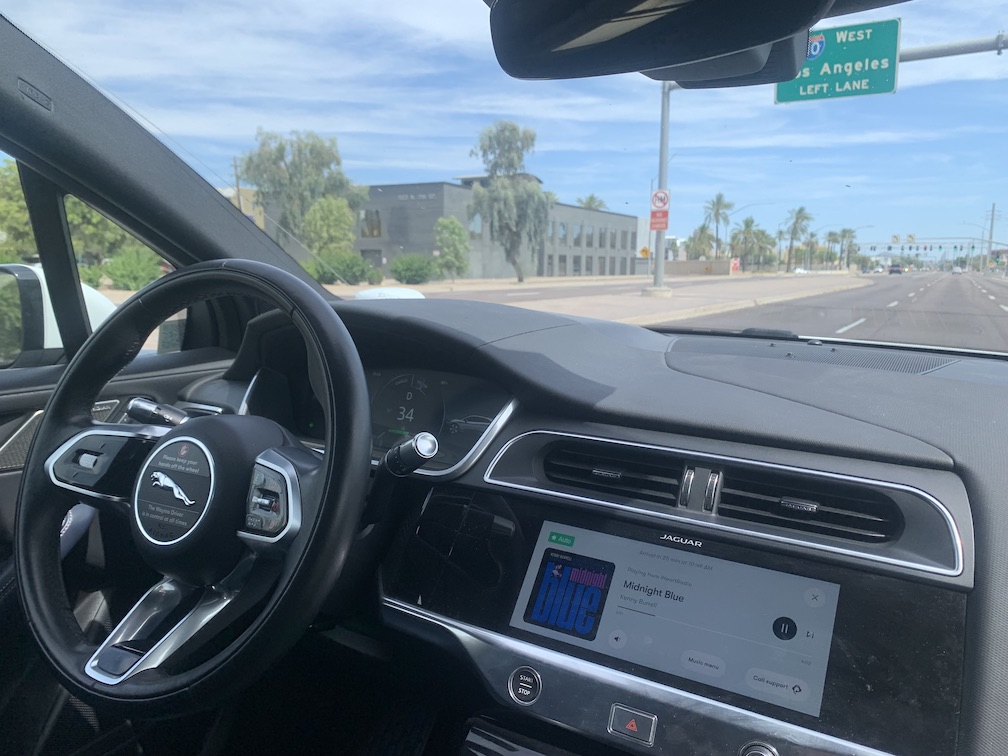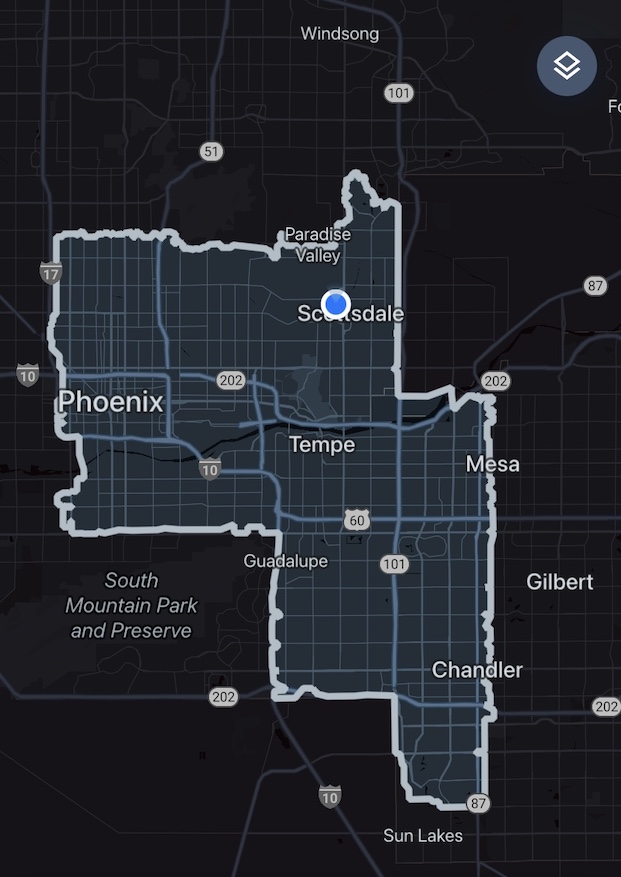posted: July 29, 2023
tl;dr: The first taxi ride in my life where the driver obeyed 100% of the traffic laws...
On July 16, 2023, my wife and I took our first two rides in a self-driving car, a Waymo. It’s not too often that you get to try a potentially life-changing technology for the first time, so I wanted to record my thoughts.
My hopes for this technology are described in my Self-driving cars can’t get here fast enough post. As a bicyclist and motorcyclist, I see evidence every day of just how bad human drivers are, as I have to avoid them. My impressions are backed up by statistics: there were 42,795 traffic deaths in 2022 according to the NHTSA. Humans do some really stupid things behind the wheel, and I’ve long believed that it ought to be possible to develop computerized systems that would outperform them. I’m not expecting perfection from self-driving cars: I just want technology to, finally, significantly reduce the number of deaths on U.S. roads. Most humans would rather use their smartphones than drive anyway.
For years I’ve seen Waymo and other self-driving car companies operating their vehicles on the streets here in the Valley of the Sun. For the same reasons that the Valley was a major pilot training center during World War II (sunny weather and benign geography), it is also one of the best places in the country to train self-driving cars. A few weeks ago I started seeing, while walking the dog, a driverless Waymo parked in our neighborhood, apparently waiting to be summoned for a ride. So I knew the service was getting close to being launched. It is now available, but only in a limited subsection of the Valley: basically downtown Phoenix, Scottsdale, and Tempe, and not much beyond that. If we lived a little further north, we wouldn’t be able to use it, although I’m sure they will be expanding the service area.

Look ma no hands!: Waymo going north at 34mph on 7th Street in downtown Phoenix
My wife and I both felt that our Waymo experience was fun, funny, and safe. The primary user interface is a smartphone app very similar to those of Lyft and Uber. We both laughed as we saw the Waymo car enter our neighborhood, and navigate its way over to our curb to pick us up. It didn’t allow us to open the driver’s door, but the handles for the other three doors popped out. I am not a control freak when it comes to driving, and have no problems with other people (and now self-driving cars) chauffeuring me around: it’s a luxury. I’ve never considered driving a four-wheeled vehicle to be all that much fun: two wheels is where it’s at for me. It was fun to have Waymo drive us around, so that we could both talk and enjoy the scenery and music system.
As for safety, I’ve already had years of experience with Waymo where I was a pedestrian, bicyclist, or motorcyclist who crossed paths with a Waymo vehicle. The Waymo vehicles, even though they usually appeared to have a human behind the wheel (but was the human actually driving it?) always behaved safely and courteously. I’ve never been cut off by a Waymo. What would I rather encounter in an intersection: a Waymo or a distracted mom in a Honda Odyssey minivan with four screaming kids in the back who are late for soccer practice? I’ll choose the Waymo, every time.
There were two occasions that nearly brought tears of joy to my eyes. The first was at a major intersection, where Waymo was briefly stopped at a red light before turning right. When the light turned green, Waymo slowly pulled ahead before halting. The pedestrian signal had also changed to “walk”, and there were two bicyclists approaching in the crosswalk. Waymo patiently waited for the bicyclists to clear the crosswalk before turning right. I daresay 90% of human drivers would have gunned it when the light turned green and cut off the bicyclists. That happens to me all the time. On another occasion, Waymo safely executed a right-on-red by coming to a complete stop and making sure both crosswalks were completely clear before proceeding. Many human drivers treat right-on-red as right-all-the-time. Waymo also noticed and avoided a zombie pedestrian: a person just wandering in the median of a four lane road, far from any crosswalk or intersection. If you watch the Waymo touchscreen closely, it displays simple geometric shapes for the various objects that it sees, and it saw the pedestrian.
Waymo never exceeded the speed limit. Waymo obeyed all traffic laws, making my two Waymo rides the only taxi rides I’ve ever taken in my life where that was the case. It was very different from that time in China when my driver went onto the sidewalk to avoid some traffic congestion. I never felt the slightest bit uneasy or worried, although when I told people about my Waymo rides, many congratulated me for my bravery. The other major reaction I got was disbelief that there was not actually a human being behind the wheel. When it comes to taxis, I have experienced the future: rather than fearing it, we should welcome it.

Waymo’s Valley of the Sun service area as of mid-July, 2023
Is Waymo an example of artificial intelligence? There’s a tremendous amount of buzz about those two words these days, but I hold to the traditional definition of artificial intelligence: a computer system which is capable of demonstrating general-purpose human-like intelligence, i.e. something which can pass the Turing test. Waymo is not that. It’s much more like Deep Blue, a computer system which was programmed and trained to play chess, and only play chess. Waymo is an example of machine learning: the system has been trained, repetitively, to drive the streets of the Valley of the Sun. I’d be very surprised if it is entirely based upon machine learning. I expect that it has been programmed with general rules and algorithms. At least that’s how I would build Waymo. An example rule: “always come to a complete stop before attempting a right on red.”
One objection I hear to Waymo is “driverless vehicles will never fully replace human drivers - would you trust Waymo to drive you home from O’Hare airport in a blinding snowstorm?” That’s the wrong goal (also, I’m not sure I would trust a human taxi driver to make that trip safely). Waymo doesn’t have to replace human drivers for 100% of trips: the system can always refuse to take on passengers in conditions that exceed its capabilities. Perhaps some Uber and Lyft drivers can step in and make some serious cash in those situations. Waymo also does allow a human driver to operate the vehicle. There have to be at least a few Waymo employees in the operating area, to rescue a vehicle if it becomes disabled.
For Waymo to survive, it just needs to be economically viable, and that won’t be proven for years. It needs to have a large enough operating area, and to operate under enough conditions, in enough metropolitan areas, to attract enough customers. It needs to deliver enough economic benefit (i.e. primarily cost savings by not having many humans involved) to both customers and to Waymo’s owners. Customers need to benefit from lower fares, or from fares equal to Uber and Lyft with a better, safer ride experience. For Waymo’s owners, the cost of the electronics added to the Jaguar EV and the back end servers and software and support systems needs to be more than offset by operating savings from not having as many humans involved in operating the taxi fleet. Who knows today how long Waymo’s Jaguars will actually last, and how much their service and repair costs will be over time? It also needs to avoid accidents that could ruin it through either lawsuits or bad publicity. The answer to all these questions will determine whether Waymo survives in the long run, not how well it drives in the most extreme weather conditions.
In the meantime I am very much looking forward to my next Waymo ride.
Related post: The app will take your order now
Related post: The algorithms will appraise your car now
Related post: The algorithms will determine your price now
Related post: The smartphone will help you rent your home now